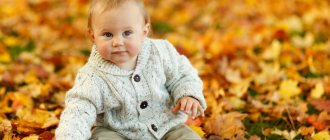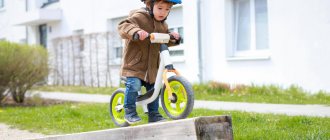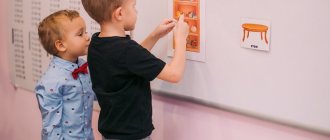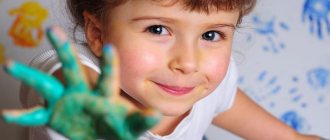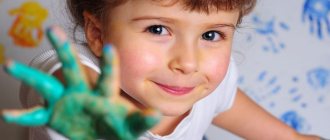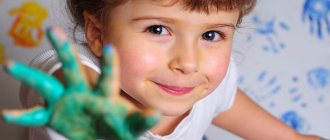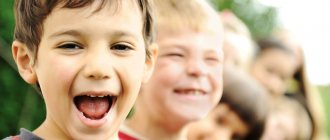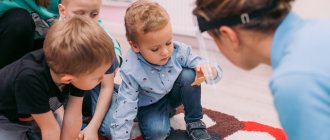Baby's body: new stages of development
At 2 years old, a child becomes more mature, he sleeps less, knows how to concentrate on one activity, and the palette of his emotions becomes richer.
- The work of his heart and blood vessels is stabilized, the heart beats slower - up to 115 - 120 beats per minute, the pressure decreases. Unlike the first year of life, now the brain is better supplied with blood due to the vertical position of the body, which gives a powerful impetus to the development of cognitive abilities.
- The intestines work more efficiently, the volume of the stomach increases. By age 2, a child usually has all 20 baby teeth.
- Bones become stronger, movements become more coordinated, accurate, and confident. However, the baby still gets tired quickly and needs a change in activities. But he gets no less tired from the lack of movement than from the movements themselves.
- The cerebral cortex improves, memory develops, and the endurance of the nervous system increases. The child goes longer without sleep, the ability to concentrate on one activity improves (up to 10–15 minutes at 2 years and 20–30 minutes at 3 years); the baby gradually learns to regulate his impulses and desires, and emotions become more varied.
- The volume of the bladder increases (by the end of the 3rd year of life - almost 4 times), and therefore the child goes to the toilet less often. By the age of 2, potty training is usually well developed, although failures may occur, especially under stress. By the age of 3, children themselves can respond in a timely manner to a full bladder.
We stretch the rubber bands on the geoboard
Geometric, also known as geoboard, also known as math tablet (My-shop, KoroBoom) is a fairly popular educational toy these days. I already wrote about it in an article about logic games, and I will repeat it here. Why? Because for a two-year-old child, a tablet is primarily relevant as a simulator for the development of fine motor skills. Do you think it’s easy to stretch and tighten rubber bands on nails? The task is not trivial for a child, but with due diligence the child will definitely master it. The child will be happy to build endless webs, conquering unyielding rubber bands.
And when the skill is mastered a little, you can show your child that it is also interesting to create pictures from rubber bands. Here is a list of the most “hit”, in our opinion, pictures for designing - a comb, a table, a chair, a man, flowers, a Christmas tree, a flag, letters. The pictures are simple and therefore well suited for beginners.
Taisiya and I had the simplest geometrics (as in the photo above), but now the manufacturers have gone further - in the kit of some geoboards you can also find cards with tasks! The essence of the tasks is for the child to complete existing pictures using rubber bands. I really like this “addition”, because it makes the geoboard even more accessible to kids. This is a wonderful preparatory stage for the independent construction of paintings.
Height and weight of a child from 2 to 3 years old
During this period, your baby is growing a little slower than in the first 2 years, although he is still active. During the 3rd year of life, the child gains: height - 8 - 10 cm, weight - 2 - 3 kg. At this age, the child’s legs grow fastest, his head grows slower, but the brain continues to increase in volume.
How to figure out whether your baby’s development corresponds to age standards? Here is a simple formula for determining the normal ratio of height and weight (from 1 year to 6 years): body weight (kg) = age (years) * 2 + 8; body length (cm) = age (years) * 6 + 77.
To judge harmonious development, it is necessary to consider the child’s weight in accordance with his height, and not age. Weight values within 6 - 7% are considered normal; the tendency to “overweight” or “underweight” can be judged when these figures deviate from the average by 7 - 14%, about slight “underweight” or “overweight” - by 12 - 14%, about the need for nutrition correction - by 20 - 25%. As for growth indicators, values within 3% of the “standard” are considered the norm; with a deviation of more than 10%, specialist advice is needed.
A more complete picture of the norm and deviations from it for certain physical parameters is provided by special centile tables developed by the World Health Organization.
Normal ratio of indicators for children 2 years old:
- Boys: height - from 84.5 cm to 89 cm, weight - from 12 kg to 14 kg;
- Girls: height - from 82.5 cm to 87.5 cm, weight - from 11.5 kg to 13.5 kg.
Normal ratio of indicators for children 3 years old:
- Boys: height - from 92 cm to 100 cm, weight - from 13.5 kg to 16 kg;
- Girls: height - from 93 cm to 98 cm, weight - from 13 kg to 15.5 kg.
The baby grows “differently” in comparison not only with his peers, but also with himself: sometimes the child experiences growth spurts. This usually happens around 4 years of age and during adolescence. This is a healthy, natural phenomenon. It has been noticed that girls are 1 to 2 years ahead of boys.
What determines the height and weight of a child?
- Heredity: physique, height, weight - these characteristics are largely determined by the genes that the baby receives from his parents; at the same time, boys follow in the line of development their predecessors along the male line, girls - along the female line.
- Intrauterine development: the absence of injuries, stress, illnesses and pathologies during pregnancy, as well as a balanced diet of the expectant mother - all this is important for the health of the child.
- External factors: ecology, climate, nutrition, including the mother’s diet during pregnancy. With nutrition, the child’s body must receive all the necessary vitamins, minerals, macro- and microelements. Calcium and vitamin K2, which are present in Agusha curds, are especially important: they help the absorption of other substances, for example, those responsible for the skeletal system (calcium and phosphorus). Daily outdoor games, especially in the fresh air, are also very important for full development.
- Some health features, such as hormonal balance. The endocrine system is responsible for human growth. And since growth hormone is released at night, it is important to follow a daily routine, putting the baby to bed on time. It is necessary to consult with an endocrinologist if you notice that the child is not gaining centimeters or is gaining too much weight; Once the correct diagnosis is established and the cause of the disorder is eliminated, the rate of growth and weight gain gradually normalizes.
You can try to approximately determine the future height of the child using the following formula: height (cm) of the father + height (cm) of the mother / 2 - 6.5 cm (for girls); father's height (cm) + mother's height (cm) / 2 + 6.5 cm (for boys).
Child's hearing and vision
Already at 2 years old, a baby can recognize objects that are not visible to him by sounds. Closer to 3 years, a child has formed a meaningful perception of all the sounds of his native language, and it is still difficult for him to distinguish them only by pitch. We advise you to train your hearing: play pieces of music for your baby, find examples of sounds in nature and in the city, play with the “low” and “high” voices of the characters.
- A child’s vision becomes similar to that of an “adult” at approximately 3–4 years of age, and color vision develops by 4–5 years of age. But unlike hearing, eye growth and development is not completed by the age of 2–3 years, but continues throughout the years of childhood and adolescence.
- Before reaching school age (7 years), children can be diagnosed with farsightedness. If it has a weak degree, then this is considered as a natural age-related feature within the normal range. Usually by about 10 years of age this phenomenon goes away.
- There are also cases when a child’s “ideal” vision hides farsightedness, which, to the best of his ability, is regulated by the muscular work of the ocular apparatus. Since the eye muscles are constantly under increased stress, trying to compensate for blurred focusing, the child begins to get tired, becomes irritable, complains of headaches and poor health.
- Farsightedness is detected only with a special examination, so you should visit an ophthalmologist at least once a year.
What examinations are necessary for a child from 2 to 3 years old?
After a fairly intensive regimen of routine medical examinations in the first 2 years of life (monthly in the 1st year, then every 3 months), in the 3rd year the child visits the clinic once every six months, and from the 4th year - once a year.
At each visit, the pediatrician measures the child’s height, weight and head circumference, and also assesses whether the child’s neuropsychic development corresponds to age standards. If necessary, the doctor will recommend consultation with a specialized specialist.
Standard medical examination at 2 years:
- Pediatrician,
- Dentist,
- General blood and urine tests,
- Examination of stool for helminth eggs.
Standard medical examination at 3 years of age (before entering kindergarten):
- Pediatrician,
- Neurologist,
- Surgeon,
- Dentist,
- Ophthalmologist,
- Otolaryngologist,
- Psychiatrist,
- Gynecologist/urologist,
- General blood and urine tests,
- Blood glucose level test,
- Examination of stool for helminth eggs.
By the age of 2, all routine vaccinations have usually already been completed (except for the Mantoux test, which is done annually). From 2 to 3 years, the baby will train his immunity, finding himself in more and more new situations, climatic, natural and sanitary conditions.
The most serious test for his immunity is still ahead, and it will begin after 3 years, when his social environment will significantly expand due to the team in the kindergarten or children's development studio.
Physical development: gross and fine motor skills
From 2 to 3 years old, the child consolidates motor skills, which he became acquainted with gradually from the moment he started. Now he hones his mastery of body and limb control, develops dexterity, and increases the speed and accuracy of movements.
Gross Motor Skills
- The child walks well, runs, jumps on two legs, squats and squats, somersaults, rises and walks on tiptoes, steps over obstacles and crawls under them, confidently jumps from a small height, climbs a wall bars, briefly balances and jumps on one leg, can walk along an inclined board, picks up objects while standing, climbs, without losing balance, up the stairs in alternating steps, at 2 years old independently overcomes the descents and ascents of stairs, by 3 years - without holding onto the railings, dances, repeating movements well and feeling rhythm.
- Catches the ball with both hands, when throwing it hits the target (ring, basket), throws it over obstacles, kicks the ball without losing balance, masters a tricycle, scooter, acquires the first skills of swimming, skating and skiing.
- Performs several actions at the same time: sings, claps his hands, spins, dances.
Fine motor skills
- The child operates well with small and thin objects: he can hold a pencil, pen, felt-tip pen with five or four fingers (by the age of 3 years - with three fingers) and draws simple lines and shapes with them, draws a straight line, copies a circle, sculpts from plasticine, strings beads on lace, flips through a book page by page, controls the index fingers of both hands well, begins to master scissors.
- Assembles a pyramid of eight elements, observing the dimensions, builds a tower of eight cubes, puts together plot structures from cubes (house, bridge, steam locomotive).
- Unfastens and fastens buttons and zippers, Velcro on clothes, tries to tie shoelaces; changes clothes on the doll; masters the buttons on the phone and the computer keyboard; deftly handles a spoon, toothbrush, and comb.
Moral education
At the age of 3 years, it is already possible to instill in children a love for their native places and develop citizenship. You should start with the development of self-respect, nobility in relation to others in everyday life, and the study of national culture. If you present it in an interesting way, children will quickly learn everything. The easiest way to instill patriotic education is through animation. There are many cartoons, both modern and Soviet, that convey noble and strong images of knights, Russian heroes, as well as brave women prone to self-sacrifice.
How does the ability to cognition develop?
At 2–3 years old, the baby’s ability to concentrate improves. He can:
- Name colors, sizes, shapes, group and distinguish objects by characteristics;
- Form simple numerical representations (one, two, many, few);
- Remember the location of objects in space (near, far); indicate the place where the toy removed by the adult stood;
- Recognize by touch and name familiar geometric or other figures; identify an item by texture;
- Embody your fantasies in the drawing and tell what is depicted; supplement what an adult has drawn with the missing details;
- Understand the causes and consequences of simple life events and draw analogies (“last time I got my feet wet while walking after heavy rain, which means if today the puddles are still not dry, I might get wet again”);
- Train memory and logic - in similar situations, he is able to discern the system and adapt his behavior to it;
- Demonstrating the purposefulness of actions - now the main thing is not the manipulation of the object, but the result. The baby begins to prefer real objects to toys, in play he imitates what he sees and imitates everything that he has learned from the immediate external environment.
By the age of 3, the child enters the age of “why”: a thousand questions about everything in the world - this is how the child’s cognitive needs develop.
Visual activities
A two-year-old child already has basic drawing skills. Visual activities promote cognitive development, so the child needs to engage in them. By drawing, the baby gets to know the world around him and himself.
Children at two years old should be able to:
- hold a pencil, felt-tip pen, brush in your hand;
- draw lines, circles, dots;
- depict simple compositions (rain, grass, sun);
- color simple drawings (flower, house, car);
- make imprints on paper with a sponge;
- skillfully paint with finger paints;
- tear off pieces of plasticine, make balls and sausages out of them, connect the ends of the sausages into a donut.
If your child does not yet master all these skills, there is no need to worry. All babies are different, and they develop at different speeds.
How speech develops from 2 to 3 years
At 2 years old, a child increases his vocabulary to 200–400 words and begins to construct phrases from 2–3 simple words or syllables.
- Most of the words used are nouns denoting objects and people from the immediate environment.
- Gradually, pronouns (“you”, “he”) and adjectives (“good”, “beautiful”) begin to appear.
- Asks questions related to the place of action: “where?”, “where to?”, “from where?”.
- Imitates the cries of animals and birds, imitates familiar sounds (car horn, special vehicle siren, steam locomotive whistle).
- Understands commands of 2–3 sequential actions (“Take a pencil and draw a sun”).
- May have problems with articulation: he does not pronounce all sounds, confuses syllables.
By the age of 3, the baby increases his vocabulary to 1200 - 1300 units, constructs phrases from 4 - 5 words, while complex words can still be shortened or replaced with simpler ones.
- In the absence of real speech therapy problems, he clearly pronounces almost all sounds, but some are still incorrect: [r], [l], whistling, hissing (it makes sense to contact a speech therapist if you have difficulties with these sounds no earlier than 4–5 years).
- Understands commands of 4–5 actions (“Go to your room, find a bear, bring it here and plant it next to us”).
Since a child’s hearing at this age is better developed than speech, he can easily miss his own articulation errors, but notice them in others. Take into account this feature of auditory perception and use it in communication with your baby, ensuring that you produce the correct sound pronunciation, because the child will copy your speech.
- Knows his first and last name, names the names of his parents, close relatives and friends; uses almost all parts of speech; changes words by numbers and cases; tells fairy tales, stories about events from his life, correctly repeats words and phrases after adults, memorizes short poems, lyrics; answer the adult’s questions based on the plot picture and compose a coherent story based on it; can complete a sentence spoken by an adult; asks questions himself and thinks about what he hears, related to the time of action and motivating reasons: “why?”, “when?”.
- Uses speech fluently in all situations of life: asks a lot of questions, willingly participates in conversation, communicates with loved ones, with children on the playground, and with strangers; constantly pronounces, accompanies all his actions and game situations with speech. Parents are required to have angelic patience: this “flow” must under no circumstances be stopped, because the child is training his speech function and enriching his vocabulary.
How communication skills and emotions develop
- A child from 2 to 3 years old is inquisitive and curious; sensitive and empathic: understands the state of another based on his experience, knows how to worry and sympathize, show attention and care; treats people in a friendly, trusting and open manner.
- Treats different family members differently, feels affection for parents and friends.
- He wants to be good, expects praise, is pleased when he is praised, is upset when he is forgotten, worries when he is scolded, and can be offended for a long time; knows how to ask for help with restraint, without hysterics, if he is experiencing difficulties.
- New complex feelings are added to the previous emotions of joy, anger, irritation, and satisfaction: the baby begins to feel proud in case of achievements and feel guilty for wrongdoing.
- At 2 years old, he introduces role-playing elements into the game, and at 3 years old - plot elements: plans his actions (“I will build a house”, “I will treat a doll”), imitates the actions of others (goes to work, cooks dinner, sits at the computer ) and social relationships (the doll can be treated affectionately and strictly).
- Copies and transfers to communication with peers and others the norms and rules of behavior in the family: if at home all controversial issues are resolved peacefully, at the negotiating table, then when playing with children the child will look for compromises, which generally contributes to easier adaptation in the team and socialization.
- By the age of 3, he plays with other children without the participation of adults: he makes acquaintances, involves another child in the game, knowing that in this case it is better to follow certain rules - share toys in order to be accepted into the company; if aggression is shown, you can get change; learns how to behave in difficult and controversial situations; in the game he takes initiative, participates in its planning, takes on roles with pleasure and is aware of them, fantasizes, easily comes up with rules (and just as easily changes them), follows them (in outdoor games); enjoys playing, especially active games.
- Begins to demonstrate clear ideas about his gender identity.
By the age of 3 years, a child is a “self-sufficient” person: the baby knows what he wants and how to achieve it. He rejects the options you offer, gets angry, cries, and can behave aggressively. Allow everything that is not dangerous, and, without entering into emotional disputes, allow the baby to carry out his plans. How else to raise a child to be independent?
Expert advice
Factors that can cause negative behavior in a child are quite diverse. Therefore, the advice of a psychologist involves, first of all, establishing the cause of whims and hysterics. Based on this, ways to solve the problem are determined.
- If the reason is overwork, you need to create a daily routine in such a way that the child has the opportunity to rest during the day.
- Excessive busyness of a child can also cause attacks of nervousness and whims. Some parents, with good intentions, enroll their son or daughter in various clubs or continuously teach them at home, which affects the psyche and leads to similar problems. You can cope only by normalizing the baby’s life and avoiding excessive stress.
- A common reason is rebellion against parental despotism. In this case, you need to allow the child to become more independent, give him the opportunity to dress himself, choose a suit for himself. It is important to ask his opinion about what to cook for dinner, where to go for a walk. Moreover, parents do not need to become obedient “servants” of their child; it is enough to show interest in his position and listen to his opinion.
- As soon as the child is about to cry, you can try to distract him with an easy-to-follow request.
Active listening can help your child deal with their own emotions and feelings. Parents can use the phrases “I see that you are upset because you broke the doll”, “I know that you are angry.” The child learns to understand himself and control his emotions.
The baby learns to be independent
At this age, the child strives to serve himself whenever possible:
- Dresses and undresses independently (the only exceptions are complex wardrobe items - tights, gloves, shoes with laces);
- Without the help of adults, eats and drinks carefully at the table, uses a napkin;
- Performs all hygiene procedures - washing, washing and drying hands, brushing teeth, combing hair; uses the potty (mostly without reminders), a handkerchief;
- Strives to keep hands and clothes clean;
- Participates in maintaining order in the house, helps adults - wipes feet when entering the apartment, cleans the house, in his room, folds toys, makes the bed, puts clothes in the closet, cares for pets and plants.
Daily routine for a child from 2 to 3 years old
For the normal development of a child, it is important that parents try to follow a regime that would allow the baby to fully recover from physical and neuropsychic stress, because all body systems continue to develop at an accelerated pace and are under serious stress. Despite the fact that the child seems cheerful and energetic, by the early evening, and sometimes by the middle of the day, he may begin to experience overload, so it is important to wisely regulate the level and nature of his activity during the day. What kind of daily routine can a 2-3 year old child have? We will talk about this in detail in a separate article, but for now the most necessary information.
- Dream. The need for sleep approaches 10 – 12 hours a day. Although children of this age generally need one nap of 1.5 to 2 hours during the day, some babies may begin to refuse it.
Arrange a quiet hour without sleep: you can let your baby look at pictures in books, listen to audio fairy tales, or play with his favorite doll during a quiet hour. The child’s nervous system must be relieved of impressions so that the mood remains good and cheerful until the evening.
- Feeding. Five meals a day with an interval of 2 - 3 hours (breakfast, second breakfast, lunch, afternoon snack and dinner).
- Wakefulness. If the baby sleeps during the day, then his periods of wakefulness are 5–6 hours. Due to the imperfection of the nervous system, a child at this age can only concentrate on monotonous activities for a short time (20-30 minutes by 3 years), gets tired easily or, conversely, gets excited. It is wise to alternate different types of activity throughout the day.
- Walks. Some of the child's waking hours should consist of walks in the fresh air. Even in winter, they are mandatory, but let their duration not exceed 1.5 hours: babies are still easily hypothermic. And in the summer, a child can spend all his waking hours in the fresh air, if he is not in the open sun during peak hours of solar activity.
- Water procedures. This is not only about following the rules of hygiene, but also about hardening and strengthening the body, as well as relieving muscle tension: water has a calming effect, so you can continue to take a bath in the evening - it will set your baby up for a sound sleep.
Approximate daily routine for children aged 2 to 3 years:
- Feeding: 8:00, 10:30, 13:00, 16:00, 19:00.
- Wakefulness: 7:30 – 13:30, 15:30 – 20:30.
- Sleep: 13:30 – 15:30, 20:30 – 7:30.
- Walk: 2 times a day after breakfast and afternoon snack.
What to expect from the three-year crisis
“The three-year crisis” is a rather conventional name: its time period is a year. Some children from 2.5 years old, others later suddenly begin to demonstrate independence, independence, a desire to insist on their own, to prove that they are right. We talk about this in detail here.
Now the baby surprises you: he shows stubbornness, obstinacy and self-will, contradicts you in everything and refuses to do something for the very reason that it was you who demanded it from him. Such negativism is not directed directly at you: now the baby is at war with the whole world, lashing out at everything (and everyone) that gets in his way. This is also a sign of normal development and is an indicator that, psycho-emotionally, the child is more likely to be doing well than vice versa.
About the importance of the problem
Let's consider what is associated with regular whims, disobedience and hysterics at 2.5-3 years old. First of all, it is increased nervous excitability. Moreover, in some children it is observed from birth and represents personality traits, in others it arises with age under the influence of external factors (both the education system as a whole and specific events).
Such behavior can be observed on an ongoing basis or represent attacks that occur as a response to psycho-emotional stress that accumulates over time. It is extremely important for parents to understand these factors and solve the underlying problem, otherwise all this will carry over into adulthood and become the reason that the matured child will be considered nervous, intemperate, even aggressive.
It is interesting that some children are constantly hysterical, wanting to manipulate their parents, to force them to “dance to their tune.” Babies do something similar, trying to get their mother’s attention at any cost. Older children, at 2.7 years old, become much more cunning - they understand how others will react to one or another of their actions, and often very skillfully subjugate their parents.


